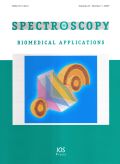Authors: Gagnon, R.E. | Macnab, A.J.
Article Type:
Research Article
Abstract:
Since clinical near infrared spectrophotometers (NIRS) first became commercially available in the early 1990's there have been more than two thousand related peer reviewed reports in the medical literature. These encompass a wide range of human and animal trials that have been directed at validating the principles, methods, and algorithms underlying the technology, as well as demonstrating its potential for specific clinical uses such as detecting concealed bleeding, onset of hypoxia, progress of ischemia, and tissue oxygenation status within human brain, muscles, organs, and tumours. In addition to its standard use as a monitor of patterns of change in the
…concentrations of oxygenated, and de-oxygenated hemoglobin residing in blood, NIRS has also been used to monitor patterns of change in the redox status of the cellular respiration enzyme, cytochrome c oxidase (Cyt a,a3 ) which utilizes the oxygen diffused from the blood. Accompanied by a tracer bolus of near infrared absorbing dye, NIRS has also been used to measure the proportional blood flow and blood volume transiting organs. NIRS has been used in conjunction with PET, fMRI, BOLD-fMRI, TCD, vascular flowmetry, MRS, NMR, plethysmography, PO2 histography, EEG, ECG, EMG, SSEP, MEP, MEG, and standard bedside monitoring devices. Herein we summarize the history, technique, algorithms, methods and advances of clinical NIRS.
Show more
Keywords: Spectrophotometry, cytochrome, hemoglobin, adenosine triphosphate, phosphorylation, mitochondria
Citation: Spectroscopy,
vol. 19, no. 5-6, pp. 221-233, 2005
Price: EUR 27.50





